Rusty cars are far from appealing. Driving a car spattered with rust can be unpleasant, and trying to sell one can be nearly impossible because rust can make the car look older. In some states, rust can even cause you to fail your inspection. This means that it is worthwhile to invest in understanding how to repair rust on a car and apply a fresh coat of paint.
Steps to Repairing Rust on a Car
The process will vary depending on the degree of damage, but in most cases, rust repair is a lengthy and difficult process. Here is what to expect from rust removal, whether you choose to take on the project yourself or enlist the help of a professional.
Collect Your Tools
If you decide to remove the rust yourself, you will need to rent or purchase specialized equipment from your local parts or hardware store. This includes a breathing mask or respirator, electric drill with sanding disk attachment, protective goggles, hammer (preferably ball-peen), paint, paint primer, rust resistant primer, 80 grit and 120 to 150 grit sandpaper, and a grinding wheel. Chemical rust remover, while not necessary, may be helpful and can be used instead of a grinder.
Put On Safety Gear
Safety gear is extremely important when removing rust from your car. Safety goggles will protect your eyes from sparks that may occur when using the grinder, and long sleeves and pants will help prevent burns from sparks and cuts from sharp edges. The rust removal process typically generates plenty of dust, which can be contaminated with chemicals, so a respirator is recommended to protect from adverse effects. If you are unable to find one, a surgical mask is a good alternative.
Mask the Car
Park your car in a well lit garage with any important items covered or removed to prevent them from getting dirty. To prepare the car, mask the parts that will not be painted with paper and tape. Newspaper and masking tape work well. Always cover panels near the area you are working on to protect from sparks, particularly the tires, glass, chrome, and any part susceptible to heat. If you are using primer, be sure to cover as much as you possibly can and leave only a few inches around the rust.
Sanding & Grinding
Using the 80 grit sandpaper on metal parts and 120 to 150 grit sandpaper on other parts, sand off the paint until you reach bare metal or rust on the affected area and adjacent components. Then, grind away the rust. Make sure the area is perfectly smooth before you continue to the painting stage. You can then paint the border of the rust holes with a rust resistant primer.
If you need to use body filler to fix a rust hole, mix the paste with the hardener and insert the included zinc metal piece behind the hole. Attach it to the car with a small amount of filler, contour the paste to the car’s body, and let it dry before painting.
Apply Primer
Apply primer to the entirety of the area to be painted, let it dry, and sand it until completely smooth. Use a finer grit sandpaper to continue smoothing by hand, which prevents too much of the panel from being removed. Continue the process of layering primer and sanding two more times. When you are ready to paint, use a 400 grit sandpaper and flexible sanding block to finish the priming.
Paint the Car
Ensure that the surface to be painted is smooth, dust free, and dry, then carefully apply the paint in a thin, even layer. Avoid painting too thickly or letting the paint drip and let it dry before sanding with 400 grit paper. Repeat the process twice more for three coats of paint and finish with a wet sand using water and sandpaper.
Apply Clear Coat
Your rust repair is almost complete. When the last layer of paint has dried, apply a clear coat to protect your work and give the car a glossy finish. Let this dry and carefully review your work toe ensure that there are no uneven areas, sanding as necessary for a smooth look.
Getting Professional Car Rust Repair Help
Repairing rust on a car is a lengthy, complicated, and expensive process that can cause a multitude of frustrations. Instead of taking the project on yourself, consider hiring an experienced professional. Contact Robs Customs and Restorations for more information about how to repair rust on a car or to work with an experienced technician on your car’s rust problems.
The team at Robs can apply a custom auto paint job that matches your current color scheme perfectly, ensuring a smooth and professional result, or update your car with an entirely new look if you take the opportunity to update its appearance while fixing troublesome rust spots.
